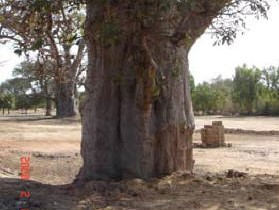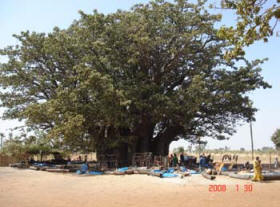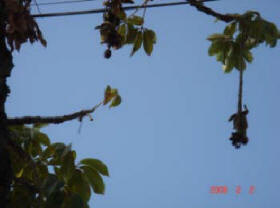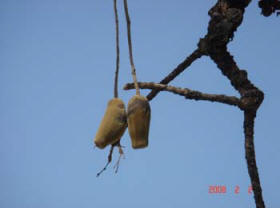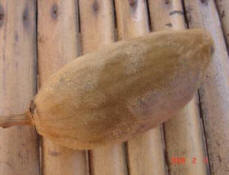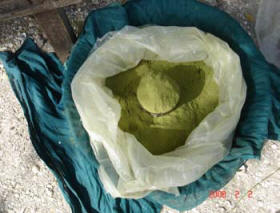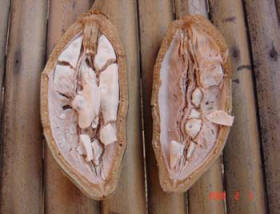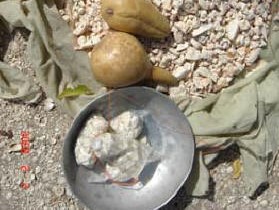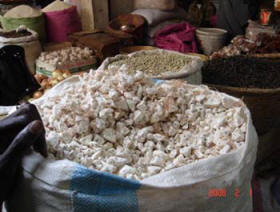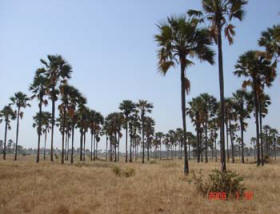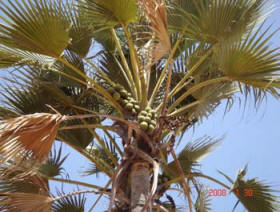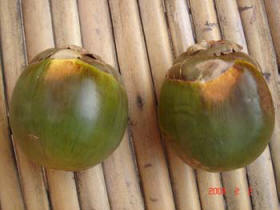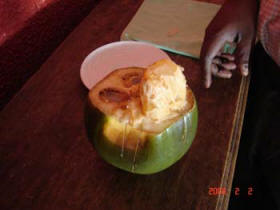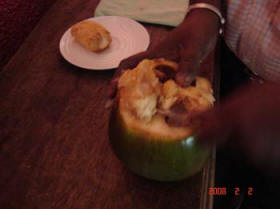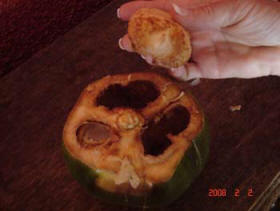Senegal
Despite our searches we have not (yet) found any traces of cocoa production in Senegal.
But there are two indirect links with cocoa:
1. The "conus cacao" shellfish.
See the animal part of the Choco-Story website.
2. The baobab.
Apparently, the Sterculiaceae, Bombacaceae Tiliaceae and Malvaceae are all part of the Mallow family.
The Sterculiaceae include Theobroma and Herrania.
The Bombacaceae include the "provision" tree (Pachira aquatica), the durian (D. zibethinus), the kapok (ceiba pentandra L.) and the baobab (Adansonia digitalis L.).
This makes the baobab a distant relative of cocoa.
The African baobab is the best known of the 8 baobab species. It is an African tree with a caudex like base of the Adansonia genus and the Bombacaceae family, according to the traditional classification, or of the mallow family according to the phylogenetic classification. Sacred for several cultures, it is also a palaver tree which it is considered inappropriate or sacrilegious to cut. It is a typical dry tropical African tree and the emblem of Senegal.
Etymology
Its name comes from the Arabic word bu hibab, a fruit with numerous seeds. Each of its oval shaped fruits contains several hundred seeds from which edible oil can be extracted.
Description
The tree with a bulbous trunk has a distinctive appearance and is reputed for its longevity; certain trees are over a thousand years old. It is generally very massive and can be as high as 25 metres and more than 12 meters in diameter with a crown of irregular branches. For nine months of the years the branches are leafless. That is one of the explanations of why it is known as the "upside-down tree" since it appears to have been planted upside-down.
Adansonia digitata has a unique botanic character in the Adansonia genus: hanging white flowers, unlike the other species with erect flowers.
The smooth, grey bark is used to make rope and rigging. A distinctive characteristic of the baobab is its ability to regenerate its bark. The sap is used in manufacturing paper.
Baobab leaves which are rich in proteins and minerals (calcium, iron, potassium, magnesium, manganese, phosphorous and zinc) are boiled for consumption. They are used in decoctions for medicinal tisanes. They are also used as fodder for livestock during the dry season.
The fruit of the baobab is oblong shaped, approximately 10 centimetres in diameter and 20 centimetres long. It contains small edible seeds with a slightly acid taste which are eaten by not only human beings but also monkeys (hence the name of monkey bread).
Longevity
The African baobab has an exceptional longevity, above all present in Senegal. It grows slowly and some specimens have lived for almost 2,000 years. As these trees do not produce tree-rings every year because of the recurring droughts which affect the African savannah, it is difficult to determine their age using dendrochronology methods.
Food and medicinal uses
When grilled, baobab seeds can replace coffee. As they are rich in phosphate, they are also used to manufacture soap and fertilizer. The pulp of fresh or dried fruit (monkey bread) is used to make drinks, which are rich in vitamins B1 and C. The young shoots and roots of young plants are eaten like asparagus.
In Senegal, lalo is a powder of dried baobab leaves, rich in calcium and iron, which is used in cereals and sauces, in particular when preparing millet couscous.
In West Africa, the dried fruit is known as "monkey bread": as a medical preparation this drink is recommended for people suffering from constipation because of its astringent qualities (=ensures strengthening).
In several villages visited, the baobab is presented as a sacred tree, either as part of pagan practices or in the conversion to Christianity.
As it ages the trunk becomes hollow. This cavity was used in the past as a burial palce for griots. Griots were/are wandering poets and musicians, guardians of oral tradition.
